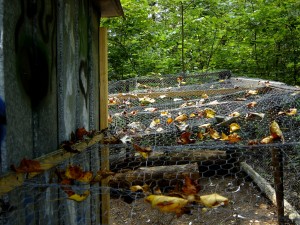I get emails every day asking about chicken diseases and I generally walk through different things with those subscribers to help them figure out what the problem is. However with a little foreknowledge and prevention, I’d like to think that problems can be stopped before they begin. This is part one of a two part series I’ve written about chicken illnesses.
Mycoplasmosis
You’ll probably first notice some wheezing and sneezing in affected birds. Then watery eyes that some people call ‘bubbly’ in appearance. If you see these symptoms then you should call a vet right away to have a look. This may require antibiotics, in fact it probably will, in which case you’ll want to wait about a week after the last treatment before eating any eggs from affected birds. With systemic infections I’ve found that anti-biotics are unfortunately required. After this a course of yogurt and/or lacto-fermented veggies is best to build up the immune system of the sick birds.
Prevention and treatment for mild cases can use minced FRESH garlic and a bit of RAW apple cider vinegar (that’s the cloudy stuff) in their water and feed. But the best method of prevention is to make sure you don’t introduce asymptomatic carriers into your flock. If purchasing new chickens take them to be tested first by a vet since once a bird has caught this bacterial disease they are carriers for life.
Avian Flu
Sometimes with Avian Influenza as well as other diseases like Exotic Newcastle Disease (also called HPAI and END respectively) the only symptoms you’ll find are dead birds. If you’re sharp-eyed or there are more obvious symptoms before the end then you’ll notice diarrhea, red flanks, purple faces and combs, and a sort of rattle and wheeze in their breathing.
Unfortunately there really is no cure for this. Prevention methods are also difficult other than the obvious measure of not introducing ill birds into your flock. Usually wild birds will bring this disease to your fowl which is very hard to stop. Netting over the run if you have a small one will help, but truly pastured birds… it’s just not practical. Any ill birds you must quarantine and have them tested, then humanely destroyed.
Coccidiosis
Coccidiosis is a disease caused by a parasite family called Eimeria, of which there are several types that can affect different parts of the GI tract. It is important to treat this quickly so the infestation does not become too severe and kill the chicken. It particularly affects young chicks because they’re immune systems are so vulnerable.
Olive leaf, mustard seeds, oregano, cloves (whole or ground), good ol’ garlic and raw apple cider vinegar, etc. can help treat and prevent this incredibly common illness. The eggs of the parasites, called oocysts, are found in the soil and in feces, especially where it’s moist like near your feeders and waterers as well as if you have any roof leaks in the coop which is why it’s so important to check for these twice a year. Some of the best prevention is just to keep everything in your coop really clean.
Botulism
Unfortunately this is another one where you might notice a dead chicken before you notice symptoms since it kills so rapidly, in only a few hours sometimes. What you probably will see first would be trembling and shaking, feather loss, and eventually paralysis before death. Just as in humans, botulism is deadly to fowls so don’t ever give them or any animal food that you don’t think is safe for a human to eat. Improperly canned food, food from dented cans, etc. But more often chicken ingest the botulism spores from water or food that has a dead animal in it or from eating insects that fed on a dead animal.
There is no natural cure for botulism. I’ve heard that you can give them water with epsom salt if you notice symptoms quickly but it didn’t work for me when I had a bird who died of this a few years ago. I just made sure to bury the raccoon carcass that fell in their feeder and scrubbed it within an inch of its plastic life. We snapped the bird’s neck so it wouldn’t suffer any more needlessly. There is an anti-toxin that the vet carries, but it is pretty expensive and when I called they said sometimes it didn’t even work. Again, it comes back to prevention here by paying attention and keeping things clean.
Bronchitis
As with humans, you’ll notice sneezing, watery eyes, coughing, etc. in affected hens. The mortality rate can be quite high in young hens and chicks usually die from this common illness. The best prevention is a clean, warm, dry living space and a good strong immune system so build your hens up with things like garlic and oregano in their feed daily. A bit of cayenne if they do have bronchitis wouldn’t go amiss.
I will have another post discussing more common bird illnesses soon! Meanwhile you might want to get started on coop project by clicking the banner below or clicking here.







